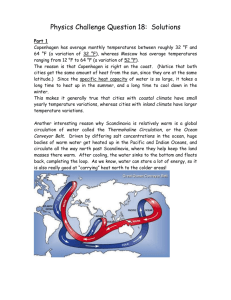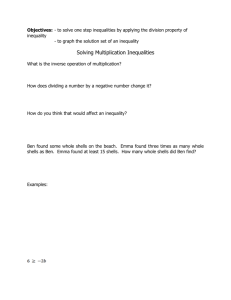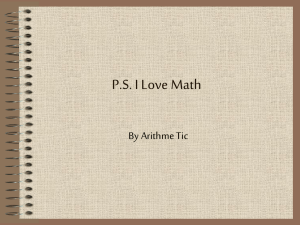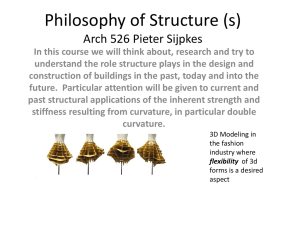PowerPoint
advertisement
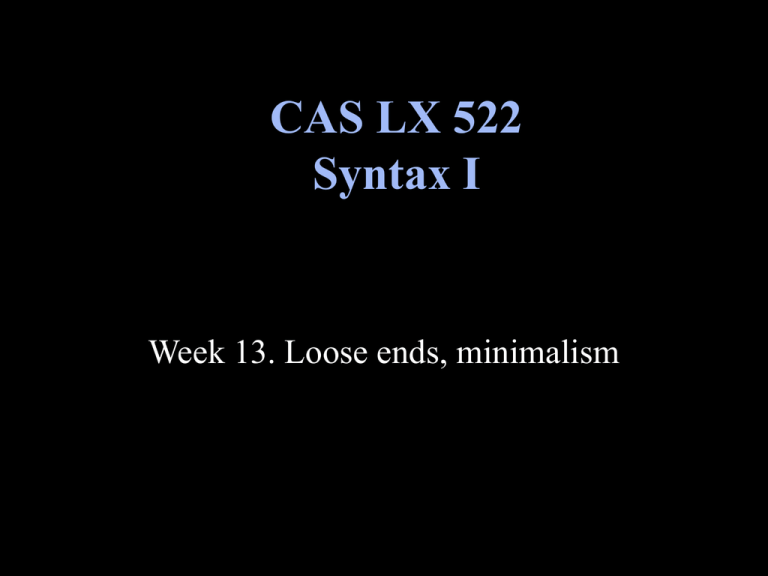
CAS LX 522 Syntax I Week 13. Loose ends, minimalism Some history of generative grammar • Transformational Grammar – (Chomsky 1955, Chomsky 1957) • Standard Theory – (Chomsky 1965) • Extended Standard Theory we’ve mostly been in here somewhere… – (Chomsky 1970, …) • Government and Binding Theory – (Chomsky 1981, 1986) • Minimalist Program – (Chomsky 1993) Transformational grammar • Grammar was a set of phrase structure rules – S NP VP NP D N VP V NP D the N man, dog, sandwich, … V meet, see, … – Start with S, apply rules until none left. • and transformations – Tpassive: NP1-Aux-V-NP2 NP2 + be + V+en by NP1 . Standard Theory • Introduced the idea of a lexicon. • Tied DS to meaning, SS to pronunciation. • Development of innateness argument and levels of adequacy (descriptive, explanatory) • Treated reflexivization as a transformation (beginnings of Binding Theory) – DS: Bill saw Bill – SS: Bill saw himself Generative semantics vs. interpretive semantics • In the late 60s there was a rift between those who thought meaning should be tied to DS and those who thought meaning should be tied to SS. • DS people were generative semanticists • SS people were interpretive semanticists – The editor didn’t find many mistakes. – Many mistakes weren’t found by the editor. • The path we’re following took the SS side. Extended Standard Theory • Replaced phrase structure rules with X-bar theory. • Gradually started replacing construction-specific rules with more general constraints (binding condition, complex NP constraint, wh-island condition) and rules (NP movement, WH movement). • Development of theta-theory. Government and Binding • Grammar has a highly modular character. Separate modules govern separate things, all have to be satisfied for a sentence to be grammatical. The logical extreme of the increasing generality. – X-bar theory – Theta theory – Case theory – Binding theory – Bounding theory – Movement rules (NP, WH, head) • Constraints began to refer to structural relations (ccommand, m-command, government) • The level of LF was introduced, and covert movement (like QR). • This it the model we have been using, basically. Minimalist Program • Since 1993, the syntactic paradigm has shifted to the Minimalist Program. • The motivation behind the Minimalist Program is that it was starting to seem like syntax was getting too complicated and that perhaps syntactic machinery that was inherited from previous approaches was as complicated as the phenomena that were being explained. Minimalist Program • The goal of MP was to sort of “start over” with syntax, now that we know what we do from the years of learning (vast amounts) about the structure of language. • We start with only things that have to be true and then we carefully justify everything else that we need as we rebuild the system from scratch. Minimalist Program • Practically speaking, what happened was a change in the fundamental perspective on what is happening in syntax, but it turned out to have little effect on the day-to-day life of syntacticians. • There’s still Case to be assigned (checked), there are still theta-roles, the trees all look basically the same. • We’ll go through things in more detail in Syntax II Ways to think • In GB theory, there were three kinds of movement rules – NP movement (movement of DPs, e.g., for Case) – WH movement (movement of wh-words) – Head movement (movement of heads to heads) • It was observed that each kind of movement served to get two things close together. – NP movement of the subject brings it into SpecTP close to T so that it can get Case. – WH movement brings wh-words into SpecCP to be close to [+Q, +WH] C. – Head movement brings V up close to T. Ways to think • So closeness seems to matter. • This evolved into the idea that lexical items (and phrases) have features and they need to be close to each other in order to be checked. • So, with wh-movement, the [wh] feature of the wh-word needs to be checked against the [+WH] feature of the interrogative C, and to do this it needs to be close. SpecCP counts as close. Hence, the wh-word needs to move to SpecCP. Ways to think • If we assume that all movement is driven by the requirement to check features, (and that all features must be checked in a grammatical derivation) then this has to be what happens in head-movement too. • The idea would be that, for example, interrogative Q has a feature on it that needs to be checked with a feature of T. • So what we say instead of there’s a rule that moves T to C when C is [+Q] that when C is [+Q] it is also [+T]. The feature checking system takes care of the rest. Other changes • There are various other changes in MP thinking which we can’t really get into here, but they all tend to have the result that we get basically the same (or simpler) structures out of a dramatically simpler system. • Somewhat fundamental changes occurred in the notion of DS and of X-bar theory, and even more recent work has even broken apart the distinction between overt and covert movement somewhat. VP shells • Let’s go back and consider VP shells a bit • The ice melted. • The boat sank. • The door closed. • The ice, the boat, the door are all Themes, suggesting that the verbs are unaccusative—the argument starts in “object” (complement of V) position. VP shells VP • V • • V DP melt the ice • So far, so good. Now, Bill melted the ice. The ice is still Theme. The verb is still melt. Uniform Theta Assignment Hypothesis (UTAH) (Baker 1988): Two arguments which fulfill the same thematic function with respect to a given predicate must occupy the same underlying (DS) position in the syntax. • So the ice must still be a complement of the verb at DS. VP shells VP V V melt DP the ice • In Bill melted the ice what have we done? • We’ve added a causer. • Bill caused [the ice to melt]. • We’ve already supposed that the light verb assigns the Agent q-role in ditransitives. • It isn’t much of a jump to think of it as having a meaning something like CAUSE. VP shells vP DP Bill • Bill melted the ice. v v VP V • Then, the main verb moves up to the light verb, yielding the surface order. – Later, Bill will move to SpecTP for Case and EPP reasons. • Why does V move to v? We’ll assume V DP that it does this for a reason analogous melt the ice to why V moves to T (for French verbs, say). VP shells • Warning. Even though v may carry a “causative” meaning, this does not mean that it is synonymous with the English word “cause”. • The water boiled. • Bill boiled the water – Billi T ti v+boil the water • Bill caused the water to boil – Bill cause TP VP shells • Bill remarked that Patrick runs fast. • Bill remarked to her that Patrick runs fast. • UTAH and the CP. • “Cause” meaning a bit more general VP shells • You must satisfy the jury that you’re innocent. • The jury gets the same kind of theta role, something like Experiencer (but no to). Also not optional. • It strikes me that Bill runs fast. • It seems to me that our analysis needs more light verbs. VP shells • Object control predicates. • Ever try to draw the tree for They persuaded Bill to leave ? Again, too many arguments, not enough syntactic places available in a binary branching tree. • They persuaded me that I should leave. VP shells • He sold me a camel. • Following along as before… • Hei T ti v+sell me tv a camel. • Compare that to He gave Mary a book. Ah. • Turns out this alternative to Larson is more crosslinguistically applicable (IO seems to start out higher in the tree than DO across languages). It also means that Bill gave me a book is the more basic form, Bill gave a book to me is more derived. VP shells • He lied. • Agent, no theme. • Suppose that Agents only come about by virtue of a v. That is, if there’s an Agent, it’s in the specifier of a vP at DS. • Compare He told a lie. The verb lie seems to be denominal. Like dance… and others. Unergative verbs • Hale & Keyser proposed that denominal verbs like lie involve head-movement of an N to to another a light (verbalizing) verb. • If we’re going to do that, perhaps we can deal with verb-particle constructions the same way. – Bill turned on the light. – Bill turned the light on. AgrSP • They have probably all left. • *They have completely probably all left • They probably all have left.


